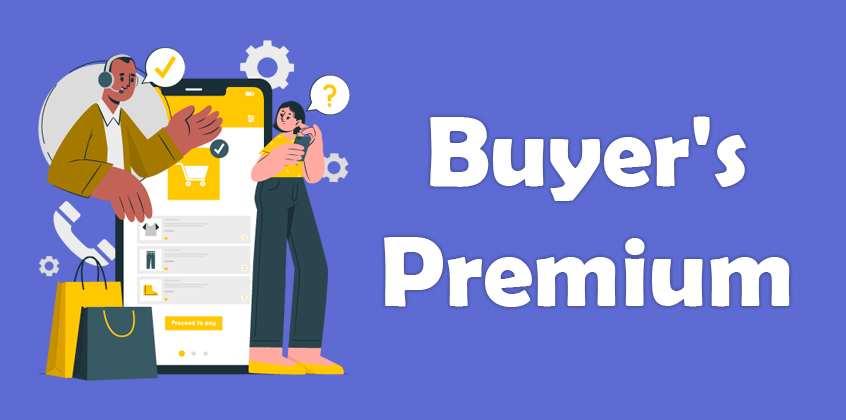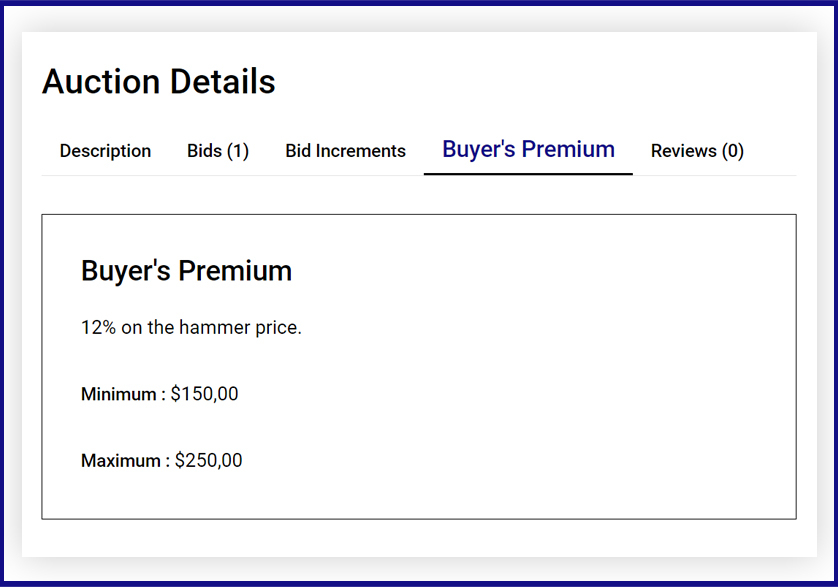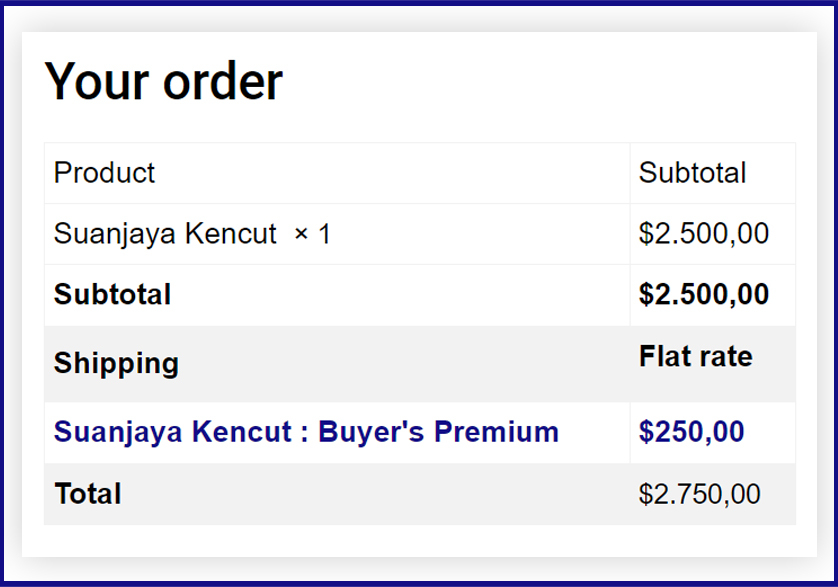Unlocking What Is a Buyer’s Premium: A Complete Guide

- What is a Buyer's Premium
- Calculation Methods: Understanding What Is a Buyer's Premium
- What Is a Buyer's Premium? Understanding Its Role and Impact
- What Is a Buyer's Premium? Insights Across Different Industries
- What Is a Buyer's Premium? Key Factors That Influence It
- An Exceptional Auction Marketplace Software: Understanding What Is a Buyer's Premium to Boost Earnings
Let’s start with the Buyer’s Premium definition. What is a Buyer’s Premium? It’s a term commonly used in the auction industry to describe an additional fee or percentage that buyers must pay on top of the final hammer price of an item. Essentially, it’s a surcharge, typically expressed as a percentage of the hammer price, that contributes to the auction process. The buyer’s premium plays a crucial role in auctions, benefiting both buyers and sellers in various ways.
The primary purpose of a buyer’s premium is to generate revenue for the auction house or seller. It helps cover the costs associated with organizing and conducting the auction, such as marketing expenses, administrative fees, and catalog production. Additionally, the buyer’s premium can also act as an incentive for auction houses to secure high-quality consignments and attract potential sellers, as it contributes to the overall profitability of the auction.
Overall, the buyer’s premium has become an integral part of the auction industry, shaping the dynamics of buying and selling at auctions. Its significance continues to evolve as the auction market adapts to changing industry landscapes and economic conditions.
What is a Buyer’s Premium
From Bid to Bill: The Buyer’s Premium Calculation Process
How the buyer’s premium functionality implemented in an Ultimate Auction Software.

The concept of buyer’s premium revolves around the additional fee imposed on the buyer during an auction. When an item is sold at an auction, the final price achieved through bidding is known as the hammer price. The auctioneer can plan to take an extra amount over the hammer price and can set a percentage or a flat fee, forming the total purchase price paid by the buyer.
Calculation Methods: Understanding What Is a Buyer’s Premium
- Percentage-based:
The most common method of calculating the buyer’s premium is through a percentage-based approach. Auction houses determine a specific percentage that will be added to the hammer price. For example, if an item has a buyer’s premium of 10% and the hammer price is $1,000, the buyer will pay an additional $100 (10% of $1,000) as the buyer’s premium. The total purchase price in this case would be $1,100. - Flat fee:
In some cases, auction houses may opt for a flat fee buyer’s premium instead of a percentage-based calculation. With this method, a fixed amount is added to the hammer price regardless of the item’s value. For instance, if the flat fee is $50 and the hammer price is $500, the buyer will pay a total of $550 ($500 + $50) for the item.
The choice between percentage-based and flat fee buyer’s premiums often depends on the auction house’s policies and the nature of the items being auctioned. Percentage-based premiums are more commonly used for high-value items, as they allow for flexibility in accommodating different price ranges. On the other hand, flat fee premiums may be employed for lower-priced items or in situations where a simple and straightforward calculation is preferred.
What Is a Buyer’s Premium? Understanding Its Role and Impact

The buyer’s premium plays a crucial role in the auction industry. The buyer’s premium serves as a vital source of revenue for auction houses or sellers. It incentivizes sellers to consign high-quality items and allows auction houses to sustain their operations while providing a platform for buyers to acquire unique and desirable items.
- Revenue generation:
One of the primary benefits of the buyer’s premium is its role in revenue generation for auction houses or sellers. The additional fee collected from buyers significantly contributes to the overall income generated from the auction. This revenue helps cover the costs of organizing and conducting the auction, such as marketing expenses, venue rentals, catalog production, and staff salaries. It also allows auction houses to invest in expanding their services and improving the auction experience for both buyers and sellers. - Incentive for quality consignments:
The buyer’s premium can act as an incentive for sellers to consign high-quality items to an auction. Auction houses often take this amount themselves or also offer it as a commission to the consignor. This encourages sellers to promote and achieve a higher hammer price which in turn will bring more commission to them. Consequently, the buyer’s premium encourages sellers to consign valuable and desirable items, as it aligns their interests with those of the auction house. This creates a win-win situation where sellers are motivated to offer exceptional pieces, and auction houses have a higher chance of attracting buyers and achieving successful sales.
What Is a Buyer’s Premium? Insights Across Different Industries

- Art auctions
Art auctions are known for incorporating buyer’s premiums as a common practice. These premiums play a significant role in the art market and contribute to the financial dynamics of buying and selling artwork. Art auction houses typically employ percentage-based buyer’s premiums, which can range from 10% to 25% of the hammer price. The buyer’s premium in art auctions not only generates revenue for auction houses but also supports the promotion of art, funding exhibitions, and expanding collections. However, the higher buyer’s premiums in the art market have also been subject to debate, as some argue that they can deter buyers or artificially inflate prices. - Real estate auctions
Buyer’s premiums have also found their way into the realm of real estate auctions. In these auctions, the buyer’s premium is typically a percentage of the final sale price and is added to the total amount paid by the buyer. Real estate auction houses utilize buyer’s premiums to cover the costs associated with organizing auctions, such as advertising, property inspections, and administrative expenses. The buyer’s premium in real estate auctions varies depending on the auction house and the specific property being auctioned. It is important for potential buyers to carefully review the auction terms and conditions to understand the applicable buyer’s premium and consider it in their budget calculations. - Online marketplaces
With the rise of online marketplaces, the inclusion of buyer’s premiums has become more prevalent. Online auction platforms often incorporate buyer’s premiums as a means to generate revenue and support their operations. In online marketplaces, the buyer’s premium is either a percentage or flat fee, disclosed before bidding. It supports the platform’s business model and enhances functionality and user experience
Buyer’s premium supports revenue and growth across various industries
What Is a Buyer’s Premium? Key Factors That Influence It

- Auction house policies and practices
The buyer’s premium can vary based on the policies and practices established by different auction houses. Auction houses have the flexibility to set their own buyer’s premium rates, whether it is a percentage-based fee or a flat fee. Factors such as the size and reputation of the auction house, the scope of services provided, and the target market they cater to can influence the buyer’s premium. Some auction houses may choose to set higher premiums to cover their operating costs or to position themselves as premium service providers, while others may opt for lower premiums to attract a broader range of buyers. - Competition and market dynamics
Competition among auction houses and market dynamics can also impact the buyer’s premium. In highly competitive auction markets, where multiple auction houses are vying for consignments and buyers, there may be downward pressure on buyer’s premiums as auction houses strive to attract and retain clients. Conversely, in specialized markets with limited competition or high demand for specific items, buyer’s premiums may be higher due to increased bargaining power or scarcity of alternatives for buyers. - Value and rarity of the item being auctioned
The value and rarity of the item being auctioned often play a role in determining the buyer’s premium. For high-value or unique items, auction houses may be inclined to set higher premiums to capture a greater share of the final sale price. This is because the buyer’s premium is a percentage-based fee, meaning a higher hammer price results in a larger buyer’s premium. Additionally, rare or sought-after items may attract more competitive bidding, giving auction houses the opportunity to justify and command higher buyer’s premiums.
Special Offer – Limited Time Only!
Rev Up Your Savings: Get 10% off Essential Ultimate Auction Software!
Fill the form and receive directly to your mailbox a discount code.
"*" indicates required fields
An Exceptional Auction Marketplace Software: Understanding What Is a Buyer’s Premium to Boost Earnings
With the growing prominence of online auctions and the inclusion of buyer’s premiums, there is a need for comprehensive auction marketplace software that addresses the specific requirements of both buyers and sellers. Ultimate Auction Pro Software bridges this gap, offering a range of unique features tailored to optimize the buyer’s premium experience.
- Seamless Payment Integration
Ultimate Auction Software facilitates smooth payment processing, integrating secure payment gateways to ensure swift and hassle-free transactions for buyers. By automating the calculation and collection of buyer’s premiums, the software eliminates the need for manual calculations and reduces the chances of errors or discrepancies. - Transparent Fee Disclosure
A key aspect of buyer’s premiums is transparency. Ultimate Auction Software emphasizes clear and upfront fee disclosure, providing buyers with a breakdown of the buyer’s premium percentage or flat fee at the point of bidding. This fosters trust and enables buyers to make informed decisions based on the total purchase price. - Personalized Budget Management
Ultimate Auction Software features personalized budget management tools, allowing buyers to set their maximum bid amounts while factoring in the buyer’s premium. This empowers buyers to bid confidently within their budget constraints, preventing any unwelcome surprises when the final invoice is issued. - Auction Notification and Tracking
Keeping buyers informed is crucial to a successful auction experience. Ultimate Auction Software incorporates real-time auction notifications, alerting buyers to bid updates, outbidding scenarios, and auction closure. Additionally, it provides tracking features to monitor bidding activity, allowing buyers to stay engaged and make informed decisions until the auction’s conclusion. - Mobile Accessibility
In today’s mobile-centric world, Ultimate Auction Software prioritizes accessibility by offering a mobile-friendly interface. Buyers can conveniently participate in auctions, track their bids, and manage their buyer’s premium calculations on the go, enhancing convenience and flexibility.
General overview of how the buyer’s premium functionality implemented in an Ultimate Auction Software:
Configuration :
The Ultimate Auction Software reach theme options include an option to set the buyer’s premium rate or amount. This allows the site owner to define the additional fee or percentage that buyers will be charged on top of the winning bid. The Ultimate Auction Software also include Buyer’s premium on a product-specific basis can offer more flexibility in determining the additional fee or percentage for each item.

From Bid to Bill: The Buyer’s Premium Calculation Process
How the buyer’s premium functionality implemented in an Ultimate Auction Software.

Art auctions
The auction listing pages would typically show the current bid amount, but the Ultimate Auction Software also display the buyer’s premium separately or indicate that it will be added to the final sale price. This transparency ensures that bidders are aware of the total cost they will pay if they win the auction.

Auto Debit :
Auto debiting the buyer’s premium amount when an auction product expires is a specific feature that available in the Ultimate Auction Software.
Calculation:
When a bidder wins an auction, the buyer’s premium is automatically calculated and added to the final sale price to determine the total amount the buyer needs to pay. The theme would handle this calculation based on the configured buyer’s premium rate or amount.

Invoicing:
The theme generate an invoice or payment summary for the winning bidder, clearly indicating the breakdown of costs, including the buyer’s premium. This helps provide a transparent record of the transaction for both the buyer and the seller.
In conclusion, Ultimate Auction Software stands out as an essential auction marketplace software specifically designed to optimize the buyer’s premium experience. By streamlining the buyer’s premium process, Ultimate Auction Software revolutionizes the auction marketplace, ensuring a smooth and efficient experience for all parties involved. Visit Ultimate Auction Software to discover how it can enhance your auction journey.
Frequently Asked Questions
A buyer’s premium is an additional fee or percentage charged to buyers on top of the hammer price in an auction. It is collected by the auction house or seller and helps cover the costs associated with conducting the auction. The buyer’s premium is usually disclosed before bidding and is added to the final purchase price, which the buyer is required to pay
The purpose of a buyer’s premium is twofold. Firstly, it generates revenue for auction houses or sellers, helping to offset the costs of organizing and running the auction. Secondly, it incentivizes sellers to consign high-quality items by offering them a portion of the buyer’s premium as a commission, thereby compelling their audiences and end customers to submit valuable items to the auction.
The two main types of buyer’s premiums are percentage-based and flat fee. Percentage-based buyer’s premiums are calculated as a percentage of the hammer price, while flat fee buyer’s premiums are a fixed amount added to the purchase price. The specific type of buyer’s premium employed can vary depending on the auction house, industry, and the value of the items being auctioned.
Pros of buyer’s premiums include providing revenue for auction houses, incentivizing high-quality consignments, and helping cover auction costs. However, some cons include the additional cost for buyers, the potential impact on bidding behavior, and the perception of artificially inflated prices.
Buyer’s premiums are typically non-refundable. Once the buyer participates in an auction and successfully wins an item, they are obligated to pay the hammer price and the buyer’s premium. It is crucial for buyers to carefully review the auction terms and conditions to understand the refund policies specific to each auction house.
The cost of a buyer’s premium can vary depending on several factors, such as the auction house, industry, and the value of the items being auctioned. Percentage-based buyer’s premiums commonly range from 10% to 25% of the hammer price, while flat fee premiums can range from a few dollars to a few hundred dollars.
Buyer’s premiums are typically disclosed in the auction catalog or listed on the auction house’s website. It is important to thoroughly review the terms and conditions provided by the auction house to find the specific buyer’s premium applicable to the auction you are interested in.
Avoiding buyer’s premiums may be challenging, as they are standard practice in auctions. However, one possible way to mitigate the impact is to explore alternative purchasing channels outside of auctions, such as private sales or direct negotiations with sellers. However, it’s important to note that these options may come with their own set of considerations and negotiation dynamics.
Frequently Asked Questions
Get your own Auction Today!
Choose Your Plan
Easy Setup
5 Star Support
